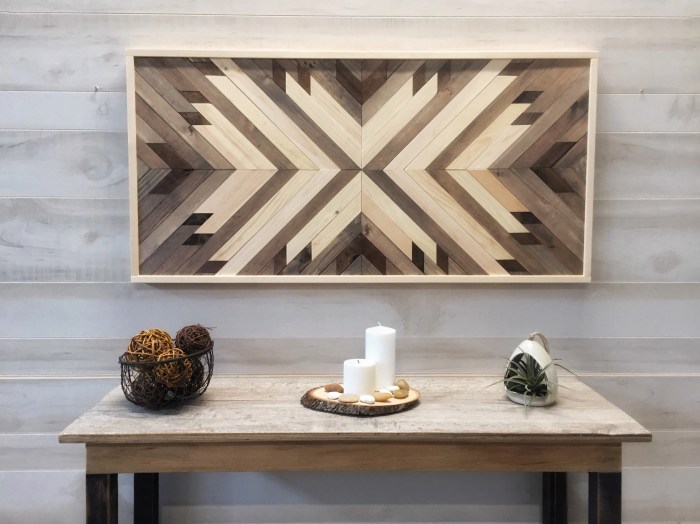Wall Decor Wood offers a versatile and aesthetically pleasing way to transform any interior. From rustic charm to modern minimalism, the possibilities are endless. This exploration delves into the diverse types of wood, design styles, manufacturing processes, and placement techniques, empowering you to create stunning and personalized wall art. We’ll cover everything from selecting the perfect wood type to mastering the art of arrangement and ensuring long-lasting beauty.
This guide provides a comprehensive overview of using wood in wall decor, covering material selection, design styles, manufacturing processes, interior design integration, and maintenance tips. Whether you’re a seasoned DIY enthusiast or a design novice, this resource will equip you with the knowledge and inspiration to elevate your home decor.
Types of Wood Wall Decor: Wall Decor Wood

Wood wall decor offers a versatile and aesthetically pleasing way to enhance any interior space. The choice of wood significantly impacts the final look and feel, influencing everything from the overall color palette to the texture and durability of the piece. Understanding the characteristics of different wood types is crucial for selecting the perfect material for your project.
Wood Types Used in Wall Decor
The selection of wood for wall decor is vast, each type possessing unique properties that contribute to its suitability for specific applications. The following table categorizes several popular wood types, highlighting their key characteristics:
| Wood Type | Durability | Grain Pattern | Color Variations |
|---|---|---|---|
| Oak | High; resistant to wear and tear | Prominent, often with a distinct cathedral pattern | Light to dark brown, sometimes with reddish hues |
| Pine | Moderate; prone to dents and scratches | Straight, with visible knots | Light yellow to creamy white |
| Walnut | High; strong and dense | Intricate, often with swirling patterns | Rich dark brown, often with streaks of lighter brown |
| Maple | High; hard and strong | Fine, even grain | Light creamy beige to light brown |
| Cherry | Moderate; relatively hard but can be susceptible to damage | Straight to slightly wavy | Light reddish-brown, darkening with age |
| Reclaimed Wood (various types) | Varies depending on the original wood type and condition | Varies greatly; often with unique markings and textures | Wide range of colors and tones, often showing signs of weathering |
Examples of Wood Wall Decor Pieces
The versatility of wood allows for a wide range of design possibilities. Here are three unique examples illustrating the use of different wood types:
Design 1: Modern Geometric Wall Art (Maple): This piece features a series of interconnected geometric shapes, precisely cut from maple wood and arranged to create an abstract design. The light color and fine grain of the maple emphasize the clean lines of the geometric forms. Construction involves using a CNC router for precise cutting, followed by careful sanding and finishing with a clear coat to highlight the natural beauty of the maple.
Design 2: Rustic Floating Shelves (Reclaimed Pine): These shelves utilize reclaimed pine, showcasing its unique character through visible knots, wormholes, and variations in color. The rustic aesthetic is further enhanced by using a natural oil finish, highlighting the wood’s texture and history. Construction involves careful selection of reclaimed pine boards, cutting them to size, and attaching them to the wall using hidden brackets.
Design 3: Intricate Wall Panel (Walnut): This elaborate wall panel is crafted from walnut, its rich dark brown color and intricate grain patterns creating a luxurious and sophisticated feel. The panel features a detailed carving, possibly a floral or geometric design, further enhancing its visual appeal. Construction involves skilled woodworking techniques, including carving, sanding, and applying a high-quality finish to preserve the wood’s natural beauty and highlight the carving.
Reclaimed vs. Newly Sourced Wood: Aesthetic Comparison, Wall Decor Wood
The choice between reclaimed and newly sourced wood significantly impacts the aesthetic of the final wall decor piece. Reclaimed wood, often sourced from old barns, buildings, or even ships, possesses a unique character marked by weathering, variations in color, and visible signs of age. This imparts a rustic, vintage, or industrial aesthetic. Newly sourced wood, on the other hand, offers a more uniform appearance, with consistent color and grain patterns.
This allows for a cleaner, more modern, or traditional look depending on the wood type chosen. The choice depends largely on the desired style and the overall design scheme of the room. For example, a rustic farmhouse kitchen might benefit from reclaimed wood, while a minimalist modern living room could be better suited to newly sourced maple or oak.
Ultimately, incorporating Wall Decor Wood into your home is a journey of creativity and personalization. By understanding the diverse options available, from reclaimed wood’s rustic appeal to the sleek lines of modern designs, you can curate a space that reflects your unique style and taste. Remember to consider the impact of wood grain, color, and lighting to achieve the desired aesthetic.
With careful planning and execution, your wood wall decor will not only enhance your space but also stand as a testament to your design vision.